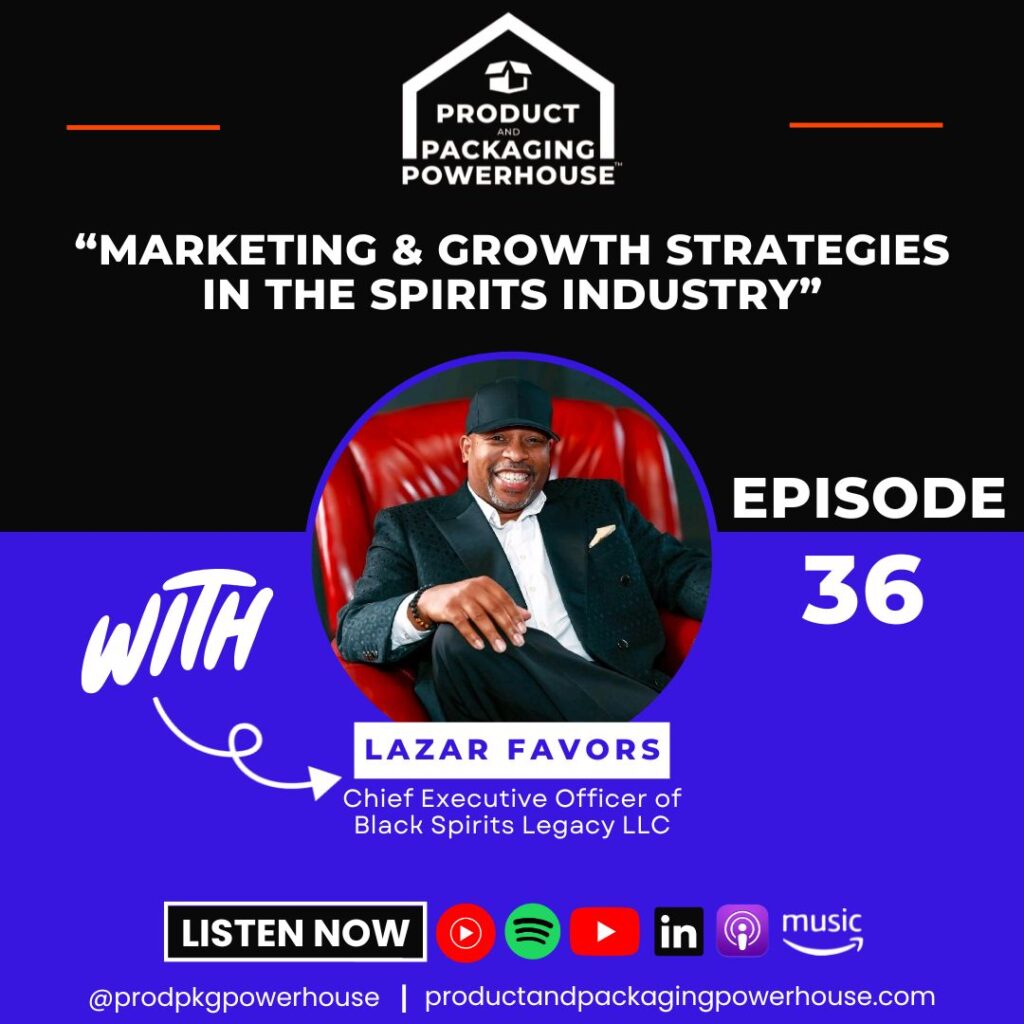What You’ll Learn in This Blog
- How to create a compelling brand identity that attracts consumers.
- Why local market dominance is essential before national expansion.
- The role of strategic marketing and distribution in long-term success.
Introduction:
The spirits industry is a competitive and ever-evolving market, where branding, marketing, and distribution strategies play a crucial role in the success of a brand. For Black-owned spirit brands, the challenge is even greater due to limited access to resources, representation, and capital.
In a recent episode of the Product & Packaging Powerhouse podcast, guest Lazar Favors, CEO of Black Spirits Legacy along with host Megan Young Gamble, shares his work on how he is changing this narrative by promoting Black-owned brands through Taste of Black Spirits and the Collective Behavior Tour.
In this blog, we explore five key marketing strategies that spirit brands can use to stand out, build strong consumer relationships, and drive long-term success.
1. Define Your Brand Identity and Story
A strong brand identity goes beyond a stylish bottle—it’s about creating a connection with consumers. Spirit brands must craft a compelling story that explains their origin, mission, and uniqueness. Without a clear narrative, it’s difficult to stand out in a crowded market. Identifying a target audience is equally important, ensuring that messaging and branding resonate with the right consumers. Packaging plays a vital role too; an eye-catching design is often the first thing that draws consumers in. As Favors emphasizes, “Your product has to dance,” meaning it should visually appeal before consumers even take a sip.
2. Conduct Focus Groups to Test Your Product
One of the biggest mistakes brands make is launching a product without consumer feedback. Focus groups allow brands to test their packaging, pricing, and taste profile before going to market. Gathering a group of consumers to compare the new product alongside competitors helps refine its positioning. If a product lacks appeal or its branding isn’t memorable, adjustments should be made before mass distribution. Consumer testing ensures that when the product finally hits the shelves, it has a higher chance of success.
3. Own Your Hometown Market First
Instead of trying to expand nationally too soon, spirit brands should first establish dominance in their hometown. Building local credibility makes it easier to gain traction in other regions. This means forming partnerships with local distributors, retailers, and bars to ensure the product is easily accessible. Community engagement is also key as brands should participate in local events and tastings to generate word-of-mouth marketing. Stock the Bar Vodka is a perfect example of this strategy. By focusing solely on the Michigan market, the brand secured placements in over 200 stores and a major airport, proving that local success can be a stepping stone to larger opportunities.
4. Build Relationships at Every Level
The spirits industry operates within a multi-tier system, meaning brands must maintain strong relationships at every stage—distributors, retailers, and consumers. Distributors are selective in what products they carry, so brands must consistently follow up and prove demand. Retailers influence product placement, so conducting in-store tastings and promotions increases the likelihood of higher sales. Consumers, however, are the most valuable asset. A loyal customer base that genuinely enjoys a product will naturally promote it through word-of-mouth, social media, and personal recommendations. When people love a brand, they share it; at work, with friends, and within their communities, leading to organic growth.
5. Be Strategic with Marketing & Distribution
Marketing isn’t just about visibility; it’s about smart investments. Brands need a well-planned strategy that aligns with their budget and goals. Digital marketing, influencer partnerships, and event sponsorships are essential tools for reaching target audiences. Additionally, distribution should be carefully mapped out rather than rushed. Some brands, like Uncle Nearest Whiskey, spent their first year heavily investing in marketing before focusing on mass sales, which led to long-term success. Expanding into new markets should be data-driven, ensuring that there’s sufficient demand before scaling up. A rushed expansion can result in wasted resources and unsold inventory.
Conclusion
The spirits industry is a challenging but rewarding space for brands that take the time to strategize their marketing and distribution efforts. From defining a strong brand identity to securing distribution and building consumer relationships, every step matters.
By applying these five key strategies, spirit brands especially those led by underrepresented entrepreneurs can navigate the competitive landscape and carve out a successful niche in the market.

Lazar’s Bio – Lazar Favors is the Founder and CEO of Black Spirits Legacy, a platform dedicated to promoting Black-owned spirit brands and expanding their distribution opportunities. He is the creator of the Taste of Black Spirits event series, which has spotlighted over 60 brands, driving awareness and growth in the industry. With expertise in marketing and strategic planning, Lazar is committed to empowering African American businesses and fostering innovation in the spirits industry. He also plays key roles in initiatives like the Detroit Black Film Festival and Trinity Films Entertainment Group, championing diversity and creativity across industries.
- LinkedIn: https://www.linkedin.com/in/lazar-favors-68626713b/
- Email id: blackspiritslegacy@gmail.com
- Company Facebook: https://www.facebook.com/blackspiritslegacy/






